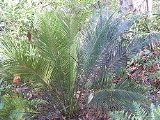
Macrozamia communis
Encyclopedia
Macrozamia communis is an Australia
n cycad
found on the east coast of New South Wales
. The common name for the species is burrawang, a word derived from the Daruk Australian Aboriginal language
; this name is also often applied to other species of Macrozamia
.
The burrawang has the most extensive distribution of any cycad in New South Wales and is found along the coast from the district around Armidale, New South Wales
to Bega
700 km south and on the coastal slopes of the Great Dividing Range
with some instances on the inland slopes of the range; as far west as the Mudgee district. It is most abundant on the south coast of the state .
The plants grow in open forests .
 Seed cones are formed after fire. Male and female seed cones are on separate plants and the large female seeds are ripe when red or yellow .
Seed cones are formed after fire. Male and female seed cones are on separate plants and the large female seeds are ripe when red or yellow .
The seeds of the burrawang are a good source of starch but are poisonous to eat unless treated. The Cadigal
people pounded and soaked the seeds in water for a week, changing the water daily. The pulp was then made into cakes and roasted over hot embers .
The conservation status of the species is "not considered to be at risk" .
Australia
Australia , officially the Commonwealth of Australia, is a country in the Southern Hemisphere comprising the mainland of the Australian continent, the island of Tasmania, and numerous smaller islands in the Indian and Pacific Oceans. It is the world's sixth-largest country by total area...
n cycad
Cycad
Cycads are seed plants typically characterized by a stout and woody trunk with a crown of large, hard and stiff, evergreen leaves. They usually have pinnate leaves. The individual plants are either all male or all female . Cycads vary in size from having a trunk that is only a few centimeters...
found on the east coast of New South Wales
New South Wales
New South Wales is a state of :Australia, located in the east of the country. It is bordered by Queensland, Victoria and South Australia to the north, south and west respectively. To the east, the state is bordered by the Tasman Sea, which forms part of the Pacific Ocean. New South Wales...
. The common name for the species is burrawang, a word derived from the Daruk Australian Aboriginal language
Dharuk language
The Sydney language, also referred to as Dharug or Iyora, is a nearly extinct Australian Aboriginal language of the Yuin–Kuric group that was spoken in the region of Sydney, New South Wales...
; this name is also often applied to other species of Macrozamia
Macrozamia
Macrozamia is a genus of 38-40 species of cycads, in the family Zamiaceae, endemic to Australia. The majority of the species occur in eastern Australia in southeast Queensland and New South Wales, with one species in the Macdonnell Ranges of Northern Territory and three in southern Western...
.
The burrawang has the most extensive distribution of any cycad in New South Wales and is found along the coast from the district around Armidale, New South Wales
Armidale, New South Wales
Armidale is a city in the Northern Tablelands, New South Wales, Australia. Armidale Dumaresq Shire had a population of 19,485 people according to the 2006 census. It is the administrative centre for the Northern Tablelands region...
to Bega
Bega, New South Wales
Bega is a town in the south-east of New South Wales, Australia in the Bega Valley Shire. It is the economic centre for the Bega Valley.-Place name:One claim is that place name Bega is derived from the local Aboriginal word meaning "big camping ground"....
700 km south and on the coastal slopes of the Great Dividing Range
Great Dividing Range
The Great Dividing Range, or the Eastern Highlands, is Australia's most substantial mountain range and the third longest in the world. The range stretches more than 3,500 km from Dauan Island off the northeastern tip of Queensland, running the entire length of the eastern coastline through...
with some instances on the inland slopes of the range; as far west as the Mudgee district. It is most abundant on the south coast of the state .
The plants grow in open forests .

The seeds of the burrawang are a good source of starch but are poisonous to eat unless treated. The Cadigal
Cadigal
The Cadigal, also spelled as Gadigal, are a group of Aboriginal Australians who originally inhabited the area that they called 'Cadi', part of which later became known as the Marrickville Local Government Area of Sydney. Cadigal territory lies south of Port Jackson and stretches from South Head to...
people pounded and soaked the seeds in water for a week, changing the water daily. The pulp was then made into cakes and roasted over hot embers .
The conservation status of the species is "not considered to be at risk" .

